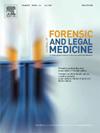证据的洗涤:不同洗涤方法对染污衣物织物体液鉴定和DNA分析的影响
IF 1.2
4区 医学
Q3 MEDICINE, LEGAL
引用次数: 0
摘要
血液、唾液和精液等体液在谋杀和性侵犯等犯罪调查中经常被发现。鉴定生物液体对调查刑事案件以查明犯罪者很有价值,往往对法院的判决具有决定性作用。意识到后者,犯罪嫌疑人往往在犯罪后清洗自己的身体和衣服,以改变证据或避免被发现。对被体液染污的衣物织物样本进行血清学检测的程度知之甚少。关于从洗过的衣服中识别体液的大多数努力主要是针对使用替代光技术和/或化学分析,假设洗涤会破坏或将血清学样品用作确认液体身份的指标的成分浓度降低到无法检测的水平。另一方面,尽管以前已经证明,在一些体液沉积后,洗过的衣服可以提取DNA,但清洗过的衣服通常不会进行DNA分析。在此,本研究展示了四种不同洗涤处理对免疫层析测试体液鉴定的影响;2)人体DNA提取的产率;3)生成的遗传图谱的完整性;三种体液,两卷,三种常见的织物。结果表明,棉质、牛仔布和涤纶在不使用洗涤剂的情况下,机洗会降低血液、唾液和精液中主要成分的浓度,使体液体积低于50 μL时,免疫层析检测体液相关蛋白的鉴定变得困难。重要的是,对于本评估中使用的少量体液,可以从血液、唾液和精液染色的棉和牛仔织物中分离出人类DNA,其质量和数量足以获得部分甚至全部STR图谱。洗涤和未洗涤的样品均显示LFI波段强度结果与人类DNA浓度没有相关性。我们的研究结果表明,在有小污渍的衣服洗涤后,仍然可以进行体液鉴定和基因分析,并通过考虑体液体积和模拟普通犯罪案件的洗涤处理,讨论了适用于实际情况的方案。本文章由计算机程序翻译,如有差异,请以英文原文为准。

The washing away of evidence: The effect of different washing treatments on body fluid identification and DNA profiling from stained clothing fabrics
Body fluids like blood, saliva, and semen are commonly found during investigations of crimes like homicides and sexual assaults. The identification of the biological fluid is valuable for the investigation of criminal cases to identify the perpetrator, being often decisive for the court's decision. Aware of the latter, suspects often clean their bodies and clothes after committing a crime to alter the evidence or avoid its detection. Little is known about the extent of serological testing of clothing fabric samples stained with body fluids after they have been washed. Most efforts regarding the identification of body fluids from washed clothes have been directed mostly towards the use of alternative light techniques and/or chemical assays, on the assumption that washing destroys or reduces to undetectable levels the concentration of components that serological samples use as an indicator to confirm the identity of a fluid. From another part, even though it has been demonstrated previously that DNA can be recovered from clothing laundered after the deposition of some body fluids, cleaned items are not routinely analyzed for DNA profiling. Herein, the present work shows the evaluation of the effect of four different washing treatments on 1) body fluid identification using immunochromatographic tests; 2) the yield of human DNA extraction; and 3) the integrity of the generated genetic profiles; on three types of body fluids, two volumes, and three common types of fabric. Our results demonstrate that machine–laundering cotton, denim, and polyester, even if no detergent is used, reduces the concentration of the major components from blood, saliva, and semen making difficult the identification of the protein related to the body fluids identification by using immunochromatographic tests when fluids volume is lower than 50 μL. Importantly, for small volumes of body fluid used in this evaluation it was possible to isolate human DNA from blood–, saliva– and semen–stained cotton and denim fabric with quality and quantity good enough to obtain partial and even full STR profiles. Both washed and unwashed samples showed no correlation between LFI band intensity results and human DNA concentration. Our results suggest that body fluid identification and genetic profiling can still be performed after clothes with small stains are washed and discusses a protocol that is applicable to real-case scenarios by considering body fluids volumes, and washing treatments that simulate what would be found in common crime cases.
求助全文
通过发布文献求助,成功后即可免费获取论文全文。
去求助
来源期刊

Journal of forensic and legal medicine
MEDICINE, LEGAL-
CiteScore
2.70
自引率
6.70%
发文量
106
审稿时长
57 days
期刊介绍:
The Journal of Forensic and Legal Medicine publishes topical articles on aspects of forensic and legal medicine. Specifically the Journal supports research that explores the medical principles of care and forensic assessment of individuals, whether adult or child, in contact with the judicial system. It is a fully peer-review hybrid journal with a broad international perspective.
The Journal accepts submissions of original research, review articles, and pertinent case studies, editorials, and commentaries in relevant areas of Forensic and Legal Medicine, Context of Practice, and Education and Training.
The Journal adheres to strict publication ethical guidelines, and actively supports a culture of inclusive and representative publication.
 求助内容:
求助内容: 应助结果提醒方式:
应助结果提醒方式:


